
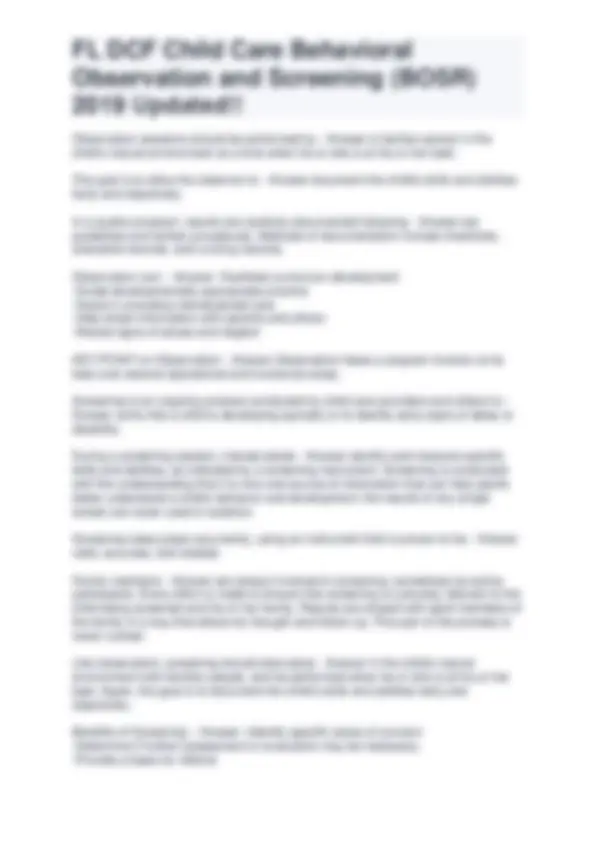
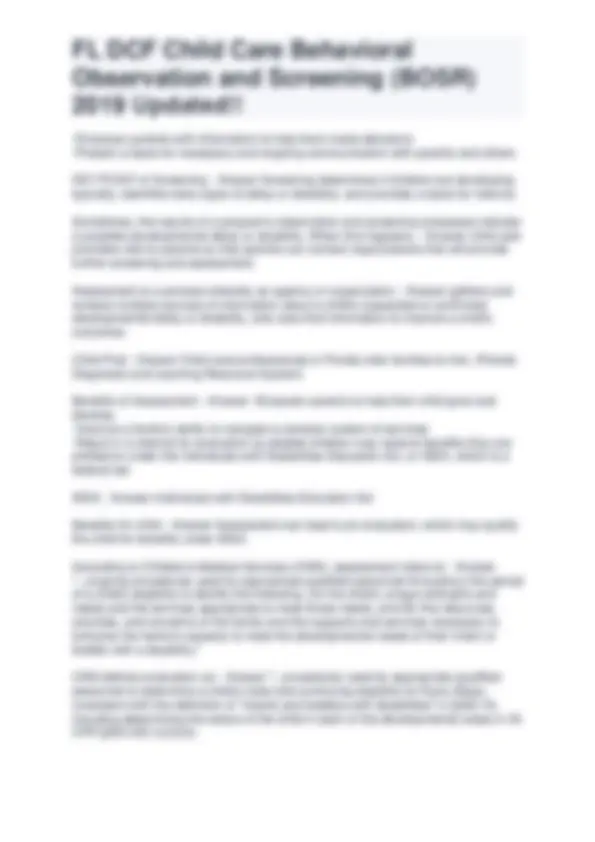
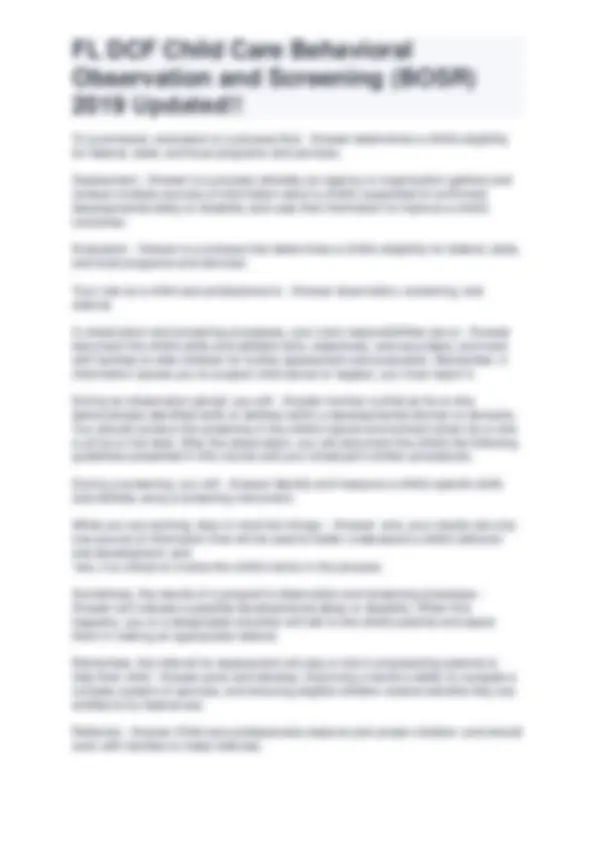
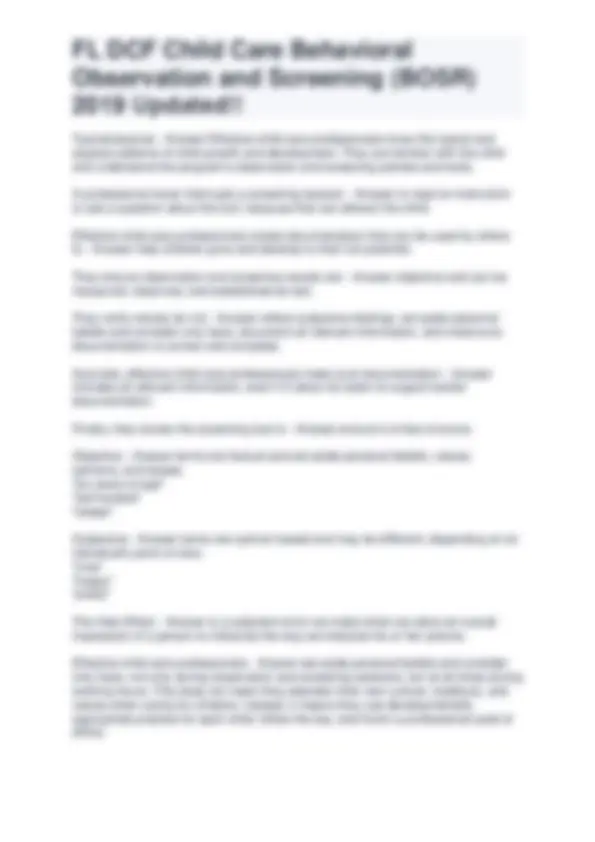
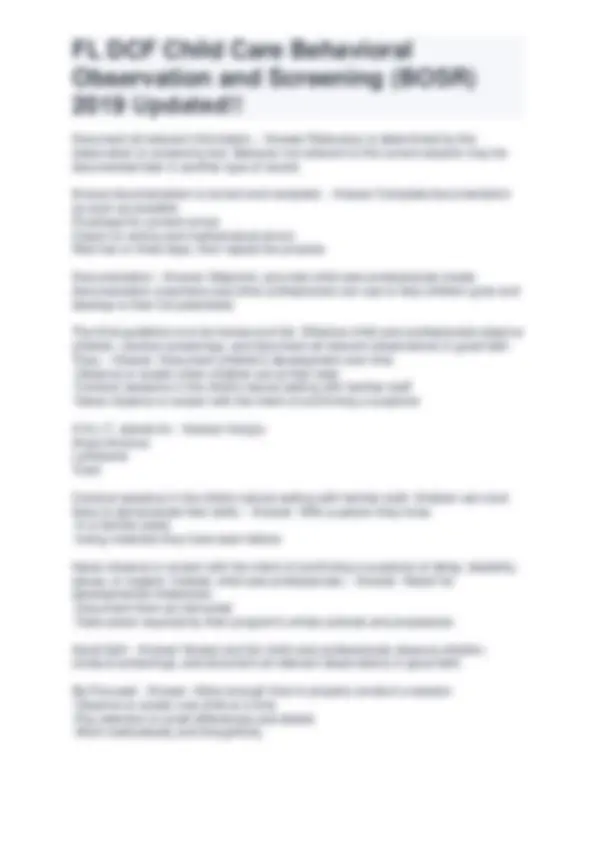
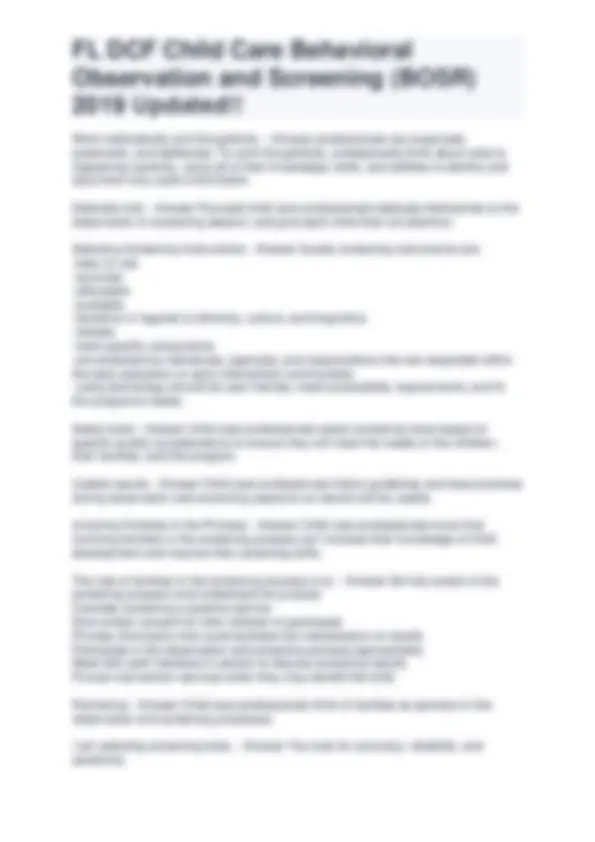
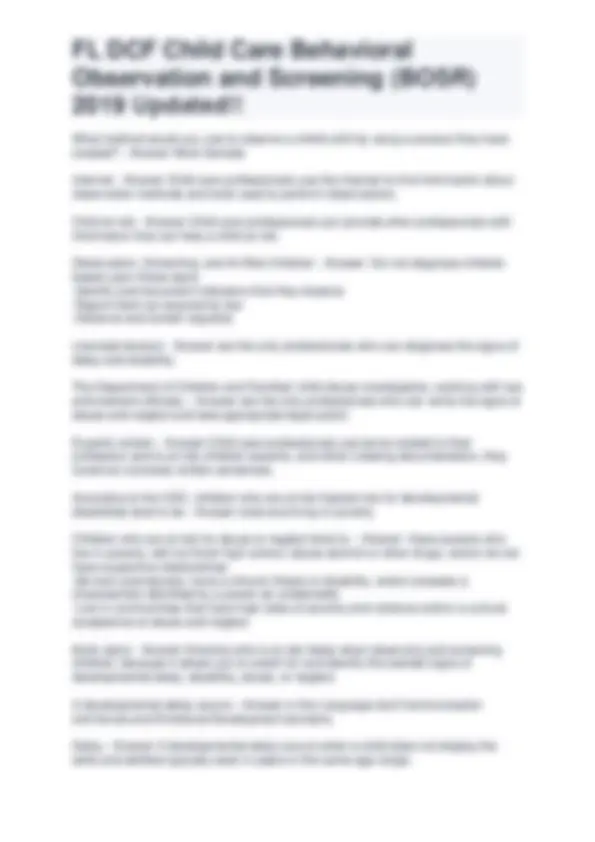
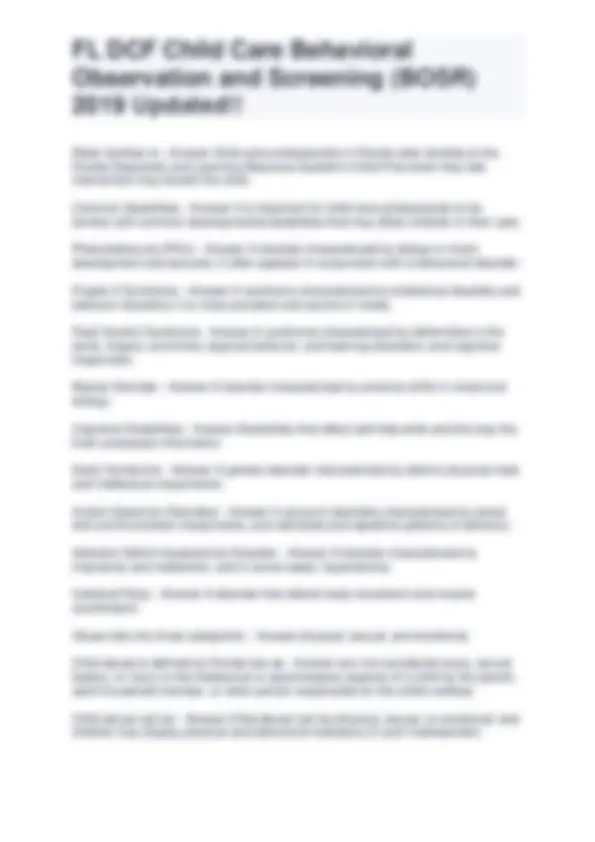
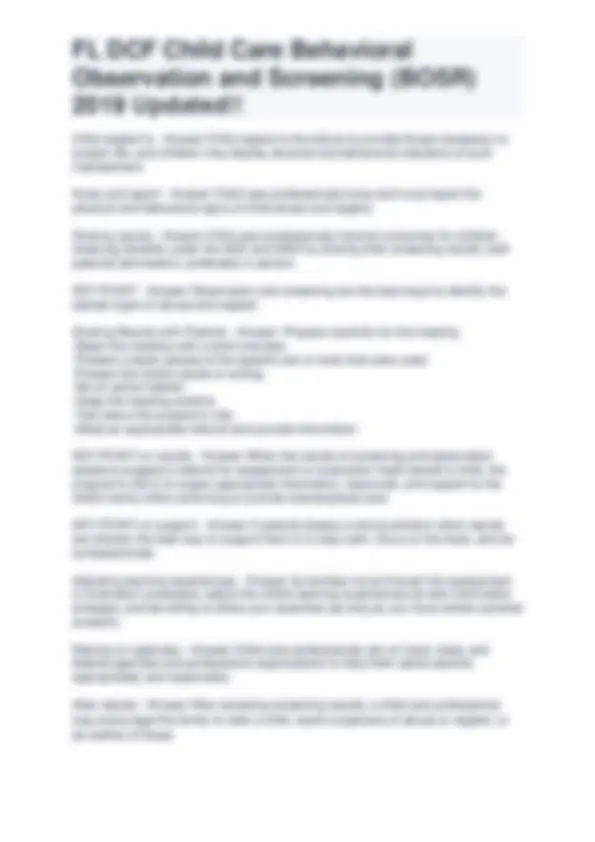


Study with the several resources on Docsity

Earn points by helping other students or get them with a premium plan


Prepare for your exams
Study with the several resources on Docsity

Earn points to download
Earn points by helping other students or get them with a premium plan
Community
Ask the community for help and clear up your study doubts
Discover the best universities in your country according to Docsity users
Free resources
Download our free guides on studying techniques, anxiety management strategies, and thesis advice from Docsity tutors
Observation and screening are essential in early childhood education. They help identify developmental milestones, support curriculum development, and facilitate early intervention services. Child care professionals play a crucial role in observing children in their natural settings, documenting progress, and collaborating with parents and other professionals to ensure children reach their full potential.
Typology: Exams
1 / 15

This page cannot be seen from the preview
Don't miss anything!










Child care professionals observe and screen children so they can - Answer 1. Facilitate the growth and development of every child in their program,
can do so anonymously. However, people who work with children are required by law to identify themselves when they report suspected child abuse or neglect. Failure to report suspected abuse or neglect is a felony of the third degree in Florida. Observation and screening support quality curriculum development by - Answer focusing learning goals and objectives, lesson plans, and teaching strategies on the development and implementation of activities that strengthen the child's skills. The best child care professionals can recognize what each child knows and can do, and uses this information to help increase skills, abilities, and knowledge. Observation and screening can help parents support their child's growth and development at home by - Answer increasing the volume and quality of information available to them. When quality information is combined with the professional services provided by a child care program, a child's outcomes improve, both at the program and at home. Observation and screening allow - Answer timely referral for intervention. The earlier signs of developmental delay or disability are identified, the better the outcome for the child. The American Academy of Pediatrics recommends - Answer that all children be screened for developmental delays and disabilities during regular well-child doctor visits at 9 months, 18 months, and 24 or 30 months. However, observation of a child can begin at birth. Observation and screening provide an opportunity for communication between parents, staff, and child development specialists because - Answer they include written evidence of a child's growth and development over time. Written records collected by a child care professional can be - Answer critical to a team of people who are helping a child with developmental delay or disability. Child care programs observe and screen children because these processes support
To summarize, evaluation is a process that - Answer determines a child's eligibility for federal, state, and local programs and services. Assessment - Answer is a process whereby an agency or organization gathers and reviews multiple sources of information about a child's suspected or confirmed developmental delay or disability and uses that information to improve a child's outcomes. Evaluation - Answer is a process that determines a child's eligibility for federal, state, and local programs and services. Your role as a child care professional is - Answer observation, screening, and referral. In observation and screening processes, your main responsibilities are to - Answer document the child's skills and abilities fairly, objectively, and accurately; and work with families to refer children for further assessment and evaluation. Remember, if information causes you to suspect child abuse or neglect, you must report it. During an observation period, you will - Answer monitor a child as he or she demonstrates identified skills or abilities within a developmental domain or domains. You should conduct the screening in the child's natural environment when he or she is at his or her best. After the observation, you will document the child's file following guidelines presented in this course and your employer's written procedures. During a screening, you will - Answer identify and measure a child's specific skills and abilities using a screening instrument. While you are working, bear in mind two things: - Answer - one, your results are only one source of information that will be used to better understand a child's behavior and development; and
Child care professionals do not confirm or diagnose a suspicion of a delay. Instead, they use - Answer developmental milestone charts to help them, and families, better understand a child's growth and development. And refer families to the Florida Diagnostic and Learning Resource System's Child Find for assessment Medical Services - Answer performs assessment and evaluation processes to determine eligibility for programs and services under the Individuals with Disabilities Education Act (IDEA). Guidelines for Observers and Screeners - Answer Be informed Be objective and accurate Be honest and fair Be focused Best Practice #1 - Answer Review appropriate general information immediately prior to an observation or screening session. This includes: Developmental domains and milestones Information about the child's abilities and unique needs Best Practice #2 - Answer Study the child's file. Look at: The results of previous observation and screening sessions Notes recorded by staff members All documentation provided by family members Samples of the child's work Use developmentally appropriate practice (DAP) when observing and screening a child to: Show sensitivity toward chronological, individual, social, and cultural experiences Help him/her behave naturally during an observation or screening session DAP - Answer developmentally appropriate practice By keeping developmentally appropriate practice in mind, - Answer the caregiver will remember to focus on the child's age, individual characteristics, and the social and cultural environment in which the child lives. Best Practice #3 - Answer Know how to use the observation or screening tool before attempting to use it. Be sure to: Read the instructions before the session begins Attend observation and screening training opportunities Keep up with changes in policy and procedure Never interrupt a screening session to read an instruction or ask a question about the tool
Typical/atypical - Answer Effective child care professionals know the typical and atypical patterns of child growth and development. They are familiar with the child and understand the program's observation and screening policies and tools. A professional never interrupts a screening session - Answer to read an instruction or ask a question about the tool, because that can distract the child. Effective child care professionals create documentation that can be used by others to - Answer help children grow and develop to their full potential. They ensure observation and screening results are - Answer objective and can be measured, observed, and established as fact. They verify results do not - Answer reflect subjective feelings, set aside personal beliefs and consider only facts, document all relevant information, and make sure documentation is correct and complete. Accurate, effective child care professionals make sure documentation - Answer includes all relevant information, even if it does not seem to support earlier documentation. Finally, they review the screening tool to - Answer ensure it is free of errors. Objective - Answer terms are factual and set aside personal beliefs, values, opinions, and biases. "six years of age" "left-handed" "obese" Subjective - Answer terms are opinion based and may be different, depending on an individual's point of view. "nice" "happy" "pretty" The Halo Effect - Answer is a judgment error we make when we allow an overall impression of a person to influence the way we interpret his or her actions. Effective child care professionals - Answer set aside personal beliefs and consider only facts, not only during observation and screening sessions, but at all times during working hours. This does not mean they abandon their own culture, traditions, and values when caring for children; instead, it means they use developmentally appropriate practice for each child, follow the law, and honor a professional code of ethics.
Work methodically and thoughtfully. - Answer professionals are organized, systematic, and deliberate. To work thoughtfully, professionals think about what is happening carefully, using all of their knowledge, skills, and abilities to identify and document only useful information. Dedicate fully - Answer Focused child care professionals dedicate themselves to the observation or screening session, and give each child their full attention. Selecting Screening Instruments - Answer Quality screening instruments are:
You assess the program's current use of technology. You perform research to find suitable endorsements. I am asking the right questions - Answer You find out what languages are available. You know the tool's target age range. You learn how many items are screened. I am following guidelines and best practices. - Answer You only use instruments for their specified purposes. You conduct screening sessions in natural settings. You are trained to conduct screening and observation sessions. I am involving families. - Answer You answer questions as you share results. You schedule confidential meetings to discuss results. You encourage parents to contact you with follow-up questions. A checklist - Answer Is a list of skills and abilities to be observed. Use a checklist when the goal is to note the presence or absence of demonstrated skills and abilities. An anecdotal record - Answer is a narrative account of an event written shortly after it occurred. Use an anecdotal record to write about the development of a skill or ability. A running record - Answer is an account of what a child is doing as it is happening. Use a running record to track a child's choice of activities or behaviors over a short period of time. A frequency count - Answer records how often a behavior happens. Use this method to identify behaviors that should be encouraged and those that may need to be addressed or accommodated. Conversations - Answer are word-for-word accounts of what children said while being interviewed by a provider. A time sample - Answer records what activities a child chooses to do during a given time period, which is usually half an hour. Use time samples to document children's attention spans, social interactions, or to see how equipment and materials meet their needs. Standardized tests - Answer are used to document a child's ability to compare and contrast, solve a problem, classify objects, put things in sequential order, arrive at conclusions, and perform other skills. A rating scale - Answer is used to measure a behavior, skill, or ability based on a series of quality points or a continuum.
What method would you use to observe a child's skill by using a product they have created? - Answer Work Sample Internet - Answer Child care professionals use the Internet to find information about observation methods and tools used to perform observations. Child at risk - Answer Child care professionals can provide other professionals with information that can help a child at risk. Observation, Screening, and At-Risk Children - Answer - Do not diagnose children based upon these signs
Refer families to - Answer Child care professionals in Florida refer families to the Florida Diagnostic and Learning Resource System's Child Find when they feel intervention may benefit the child. Common disabilities - Answer It is important for child care professionals to be familiar with common developmental disabilities that may affect children in their care. Phenylketonuria (PKU) - Answer A disorder characterized by delays in motor development and seizures; it often appears in conjunction with a behavioral disorder. Fragile X Syndrome - Answer A syndrome characterized by intellectual disability and behavior disorders; it is more prevalent and severe in males. Fetal Alcohol Syndrome - Answer A syndrome characterized by deformities in the joints, fingers, and limbs; atypical behavior; and learning disorders; and cognitive impairment. Bipolar Disorder - Answer A disorder characterized by extreme shifts in mood and energy. Cognitive Disabilities - Answer Disabilities that affect self-help skills and the way the brain processes information. Down Syndrome - Answer A genetic disorder characterized by distinct physical traits and intellectual impairments. Autism Spectrum Disorders - Answer A group of disorders characterized by social and communication impairments, and restricted and repetitive patterns of behavior. Attention Deficit Hyperactivity Disorder - Answer A disorder characterized by impulsivity and inattention, and in some cases, hyperactivity. Cerebral Palsy - Answer A disorder that affects body movement and muscle coordination. Abuse falls into three categories: - Answer physical, sexual, and emotional. Child abuse is defined by Florida law as - Answer any non-accidental injury, sexual battery, or injury to the intellectual or psychological capacity of a child by the parent, adult household member, or other person responsible for the child's welfare. Child abuse can be - Answer Child abuse can be physical, sexual, or emotional; and children may display physical and behavioral indicators of such maltreatment.